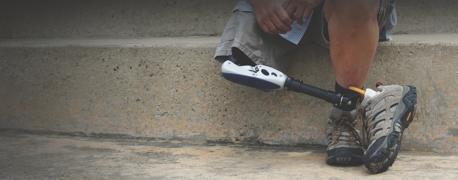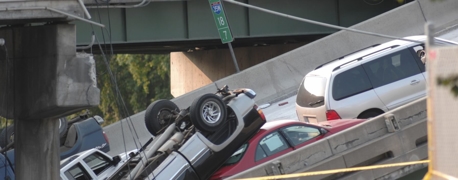How Often Are Fans Injured at Sporting Events?

"The bearer of the ticket assumes all risk and danger incidental to the sport…." This is the type of fine print you can find when you flip over your ticket to a baseball game. Is this type of language just boilerplate to ensure the stadium covers its bases, just in case? Or are you running real risks when you attend a ballpark, or other spectator sports for that matter?
Sports fans do face some real risks, sometimes as part of the sport itself, and at other times from lapses in stadium upkeep or security. We'll first examine the risks of being a fan at some of the most highly attended team sport venues, and then we'll discuss if you've waived all rights to sue a stadium simply by purchasing your ticket.
Some of the most highly attended team sporting venues in the U.S. are:
- Baseball stadiums
- Basketball arenas
- Football stadiums
- Ice hockey rinks
- Soccer stadiums
How Dangerous Is It to Attend a Baseball Game?
Known as America's pastime, baseball is the sport that holds a special place in the nation's culture, yet it can be one of the most dangerous sports for spectators. With hard baseballs that can come screaming toward you at 100 mph off of bats and straight into the stands, fans sometimes find themselves as unintended participants in ballgames. Broken bats themselves can send splintery fragments flying fast at fans too.
Baseball is a sport that loves statistics, but if you want to get the numbers on fan injuries, whether for slip and fall accidents, fan-on-fan assault, or constant foul balls, this data is difficult to find. This type of statistic is something that stadiums and teams want to downplay.
Between 2012 and 2019, more than 800 injuries were reported at baseball games, and those are just the officially reported injuries from the 4 different MLB ballparks (out of 30) that bothered to collect and share this information, combined with research into various lawsuits. These injury stats (often from foul balls) are vastly underreported.
These are just a handful of the numerous foul ball injuries and accidents that have been reported on:
- In 2008, a 7-year-old boy was struck in the head by a foul ball at a Chicago Cubs game. He spent a week in the hospital and had brain swelling to the point that doctors considered surgery. He later had to learn how to walk and climb stairs again.
- In 2011, a 12-year-old child was put in intensive care after being struck by a foul ball.
- In 2013, a foul ball sent an 18-month-old baby to the hospital.
- In 2017, a young girl was hit by a foul ball at Yankee Stadium and sustained serious injuries.
- In 1960, a fan was killed by a fly ball in a minor league stadium; it happened again in 2010.
- In 1970, a 14-year-old fan was killed by a foul ball in Dodger Stadium; it happened again in 2018, this time to a 79-year-old fan.
These incidents—and others like them—brought enough attention to the issue that all teams in Major League Baseball eventually extended the safety nets around their fields. Yet it still took nearly three years for every team to get on board and extend the safety netting, and foul or fly ball injuries are still reported from all around the stadium. Any seat beyond the protective netting is still vulnerable.
Sitting Courtside at a Basketball Game: Higher Expense, Heightened Risk
Thankfully, if you're attending a basketball game, you're not in danger of any compact projectiles flying at your head at high speeds. However, you are much closer to the action; closer than you can get in just about any other sport and without any barriers in place. This means that if you pay for courtside seats, you could have hundreds of pounds of a running or falling athlete stomping on your foot or bowling you over.
One such careening basketball player stepped unwittingly yet forcefully onto a young fan's foot, sending that courtside fan to the hospital needing an X-ray and getting discharged with a boot and crutches. In other instances, an NBA player collided with both fans as well as servers working courtside. It's not a lack of athletic talent, either. In such close quarters, there's sometimes no way for a player to stop their momentum before making impact. Even LeBron James himself accidentally gave a fan a concussion when he launched himself toward a loose ball.
In many publicized instances such as these, injured fans take it in stride and would still sit courtside again. Fans want to be that close, so they keep taking their chances.
Football: Fans vs. Fans
The netting behind the field goal posts seems to be adequate at its job, protecting fans in NFL stadiums from getting struck with a football. There are, of course, other inherent risks at a large stadium, be it your standard slip and fall accident, or other premises liability issues such as a railing collapse that led to a lawsuit in 2022. (In this particular instance, four fans at Washington Commanders' football stadium said the railing gave way as they were leaning over it, which if they can make their case, would lead to compensation from the stadium for injuries they sustained.)
However, other issues of premises liability seem to grab headlines more often: lapses in security measures. Inadequate security can mean some fans become victims of assault from other fans. While not yet touched upon in the prior sports, fan-on-fan violence is an unfortunate reality in just about every sport, and it's a distinct possibility in any highly attended sports venue, as tensions can run high, team loyalties go deep, and alcohol often flows freely.
The National Football League is no exception. One of the more recent headline-grabbing incidents was a football fan attack in a stadium parking lot at the 2022 NFC Championship. This attack led to an assault arrest for one fan, and it resulted in a medically induced coma plus head injuries for the other fan, who was wearing the jersey of the opposing team.
Hockey Pucks Can Turn Into Projectiles
We've covered at length how dangerous foul baseballs can be, and hockey pucks can similarly come flying toward fans at ice rinks. Like baseballs, hockey pucks can come flying in at 100 mph or faster. Even though hockey pucks fly into stands at a lower rate than stray baseballs do, these hockey pucks can still wreak a lot of damage.
Just from flying into fans in the stands, baseballs and hockey pocks alike can cause injuries such as:
- Traumatic brain injuries
- Orthopedic injuries
- Internal bleeding
- Blunt force trauma
One fan has died from being struck by a hockey puck. Back in 2002, a 13-year-old girl was hit in the head by a puck that deflected into the seats, and she died from complications shortly after.
The number and rate of hockey puck injuries is hard to come by, as leagues and stadiums aren’t exactly known for keeping track of this data, or at least they aren't sharing it. According to some statistics, 3-4 people get hit by a puck at each game, and one of those people will have injuries that are serious enough to require stitches or advanced medical care.
Corroborating this, one study looked at one NHL rink out of 32, as well as some data from an emergency medical response agency. Researchers found that one out of every four people struck by a hockey puck had to be hospitalized, and injuries are likely to occur where the plexiglass is lower and there is also no netting to provide a shield. (Incidentally, plexiglass itself can cause injuries, as on some occasions, the plexiglass has come loose and injured fans.)
Additionally, as with any sports venue, there are fights. While fights by hockey professionals in protective gear are part of the attraction for many fans, inter-fan fighting can cause major injuries.
The Risks You Run at Soccer Stadiums
What about the MLS? Stray shots on goal have been known to smack fans in the face or even knock them over, but nothing to the degree or severity of baseballs or hockey pucks. Soccer fan injuries in general aren't listed in a database or shared in any comprehensive way either, and many of the headline-grabbing incidents involve fans throwing items at the players themselves or onto the pitch. This does convey that certain matches can get heated, and security needs to be up to the task of keeping fans safe.
As at any sports stadium, soccer fans may face risks from the venue or the fans themselves, such as when:
- Fireworks injured a fan at the MLS All-Star Game in 2018
- In 2009, a fan suffered a burn injury from two other fans throwing flares at a sold-out MLS match in Toronto (flares that evidently evaded security measures meant to keep those banned items out of the stands)
- In 2019, one visiting fan was hospitalized after an assault from home team fans in D.C., and several other visiting fans were reported injured
Who Is Liable for Injuries at Sports Stadiums?
Let's start with the most consistently dangerous spectator sport— baseball. There is unfortunately a "Baseball Rule" that means stadiums and teams assume no liability from a stray ball or broken bat harming a fan. Each fan is said to know the risks they are running, as foul balls happen every single game, if not every single inning. Stadiums argue that if you bought your ticket, you know what you signed up for.
However, many fans and legal experts are wondering if this "baseball rule" is outdated. In this era with smaller ballparks, fans seated closer and closer to the field of play, and stadiums coming equipped with nonstop entertainment distractions on the jumbotron and across the stadium, it may be time to reevaluate what constitutes the most dangerous areas in a stadium and what the minimum standard should be to meet "reasonable protections" for fans.
Some courts have already shown signs of turning the tide. Appellate courts in California, Georgia, and Idaho have rejected the "baseball rule" in injury cases. Lawsuits do seem to be forging a way through even the baseball rule's attempt to dodge responsibility. Likewise, other sports venues may not automatically be let off the hook for negligence either.
With the right legal team putting a case together, it can be possible to sue stadiums and teams for:
- Security lapses that fail to prevent assault and other violence
- Equipment failures and/or lack of warning signage (such as with the fireworks and failed railing cases mentioned earlier)
- Injuries sustained from a lack of safety measures, such as inadequate netting
Premises liability cases are tricky, but in some cases, especially if it's a serious case, such as a cracked skull, damaged eyes, or other catastrophic injuries, it may be possible to show that sports venues committed negligence that directly led to your preventable injuries. It may be possible to prove that stadiums didn't take prior incidents seriously enough to respond with the appropriate steps to heighten security, inspect or repair equipment, or add to safety barriers. As injuries pile up and lawsuits pile in, this may pave the path for more claims to be won, forcing stadiums to make changes that ensure safety for all sports fans.


